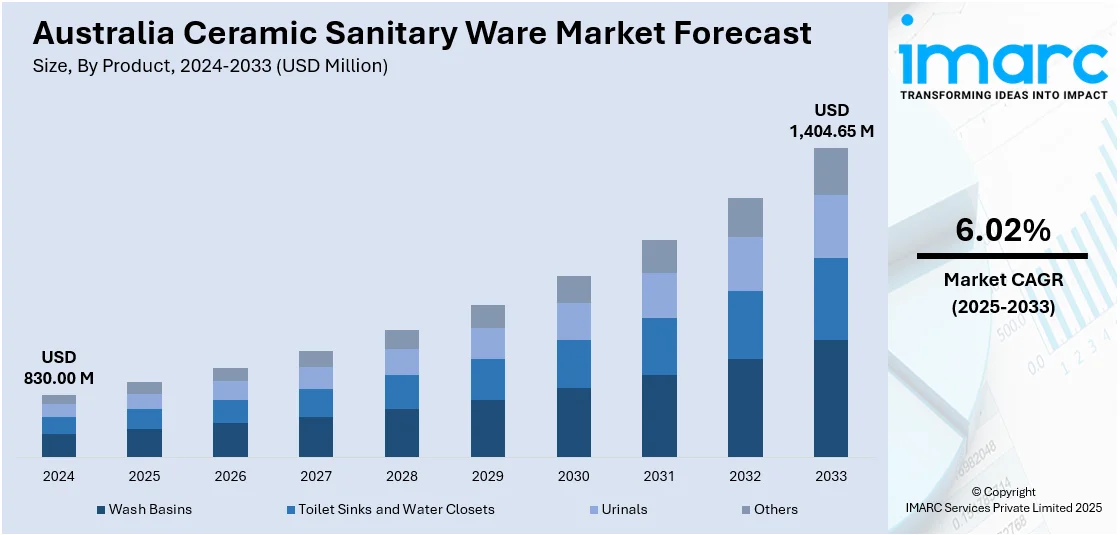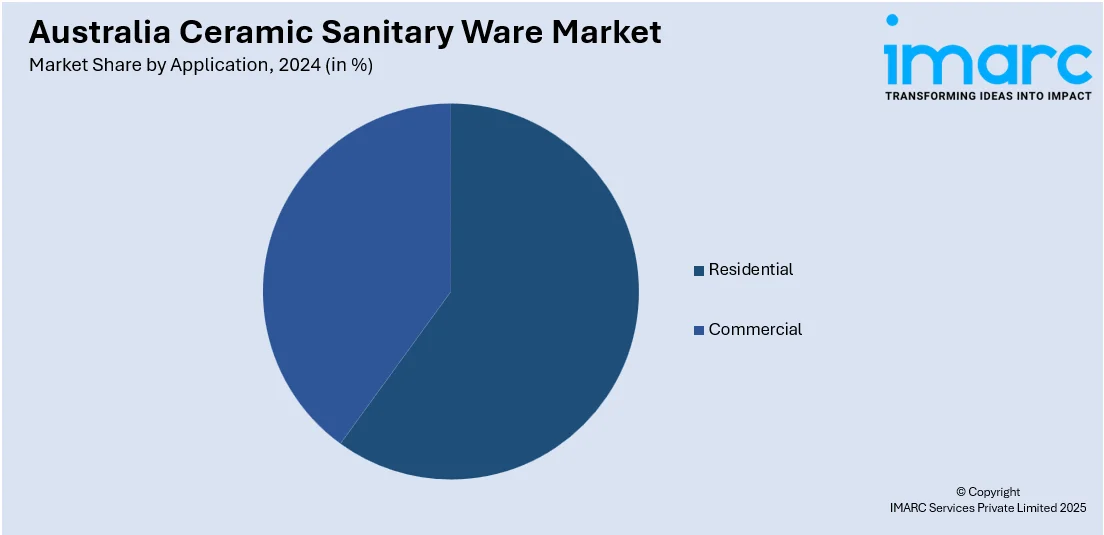
Australia Ceramic Sanitary Ware Market Size, Share, Trends and Forecast by Product, Application, and Region, 2025-2033
Australia Ceramic Sanitary Ware Market Overview:
The Australia ceramic sanitary ware market size reached USD 830.00 Million in 2024. Looking forward, IMARC Group expects the market to reach USD 1,404.65 Million by 2033, exhibiting a growth rate (CAGR) of 6.02% during 2025-2033. The market is driven by the rising residential and commercial developments, which is catalyzing the demand for sustainable and aesthetically appealing products. Additionally, the growing shift towards online shopping is facilitating access to a wider range of options, further influencing the Australia ceramic sanitary ware market share as individuals prioritize convenience and variety in their purchasing decisions.
|
Report Attribute
|
Key Statistics
|
|---|---|
|
Base Year
|
2024 |
|
Forecast Years
|
2025-2033
|
|
Historical Years
|
2019-2024
|
| Market Size in 2024 | USD 830.00 Million |
| Market Forecast in 2033 | USD 1,404.65 Million |
| Market Growth Rate 2025-2033 | 6.02% |
Australia Ceramic Sanitary Ware Market Trends:
Rising Construction and Infrastructure Development
The increase in residential and commercial projects in Australia is catalyzing the demand for premium ceramic sanitary ware, such as toilets, basins, and showers. With the rise of urban renewal initiatives and a growing demand for modern, sustainable, and visually appealing bathroom options, the ceramic sanitary ware industry is experiencing considerable expansion. The continuous emphasis on eco-friendly and water-conserving products coincides with national sustainability goals, increasing the need for innovative bathroom fixtures. A significant instance of this progression is the $3 billion in national office and residential initiatives revealed by developers Fortis and Deicorp in 2024, featuring highlights, such as Fortis’s $320 million Wiltshire House and Deicorp’s $660 million Melrose Central venture. As extensive construction efforts advance in Sydney and Melbourne to address the increasing demand for housing and commercial areas, the requirement for sturdy, premium sanitary ware keeps escalating. With these ongoing projects and investments in public infrastructure, there is an increase in the demand for stylish, sustainable, and high-performance bathroom products in both new builds and renovations.

To get more information on this market, Request Sample
Expansion of Online Retail and Distribution Channels
The expansion of e-commerce and distribution avenues is influencing the Australia ceramic sanitary ware market growth by improving accessibility and convenience for shoppers. As more people utilize digital platforms for their shopping requirements, a wider array of products, such as ceramic sanitary ware, is becoming easily available. This transition to e-commerce allows shoppers to compare costs, styles, and product attributes, enhancing their overall purchasing experience. Additionally, numerous online stores currently provide home delivery options, facilitating the purchase of large items like toilets, sinks, and bathtubs for clients. This ease of access is not only driving sales but also broadening the market by drawing in a wider and more varied group of buyers, including individuals in rural and distant locations who might have restricted access to brick-and-mortar shops. The trend is reflected by the broader expansion of the Australian e-commerce industry, valued at USD 536.0 billion in 2024 and expected to hit USD 1,568.60 billion by 2033, with a CAGR of 12.70% from 2025 to 2033, as reported by IMARC Group. The growth of online shopping platforms and services is extending the accessibility of ceramic sanitary ware brands, allowing buyers throughout Australia to discover and buy products that align with their preferences conveniently.
Australia Ceramic Sanitary Ware Market Segmentation:
IMARC Group provides an analysis of the key trends in each segment of the market, along with forecasts at the country and regional levels for 2025-2033. Our report has categorized the market based on product and application.
Product Insights:
- Wash Basins
- Toilet Sinks and Water Closets
- Urinals
- Others
The report has provided a detailed breakup and analysis of the market based on the product. This includes wash basins, toilet sinks and water closets, urinals, and others.
Application Insights:

- Residential
- Commercial
A detailed breakup and analysis of the market based on the application have also been provided in the report. This includes residential and commercial.
Regional Insights:
- Australia Capital Territory & New South Wales
- Victoria & Tasmania
- Queensland
- Northern Territory & Southern Australia
- Western Australia
The report has also provided a comprehensive analysis of all the major regional markets, which include Australia Capital Territory & New South Wales, Victoria & Tasmania, Queensland, Northern Territory & Southern Australia, and Western Australia.
Competitive Landscape:
The market research report has also provided a comprehensive analysis of the competitive landscape. Competitive analysis such as market structure, key player positioning, top winning strategies, competitive dashboard, and company evaluation quadrant has been covered in the report. Also, detailed profiles of all major companies have been provided.
Australia Ceramic Sanitary Ware Market News:
- In July 2024, Jabra Sanitary launched a new toilet collection with WaterMark and SAA certifications, meeting Australian standards for quality and safety. The smart ceramic toilets featured customized height and hole spacing tailored to local market needs. This launch highlighted Jabra’s commitment to innovation and global expansion in sanitary ware.
Australia Ceramic Sanitary Ware Market Report Coverage:
| Report Features | Details |
|---|---|
| Base Year of the Analysis | 2024 |
| Historical Period | 2019-2024 |
| Forecast Period | 2025-2033 |
| Units | Million USD |
| Scope of the Report |
Exploration of Historical Trends and Market Outlook, Industry Catalysts and Challenges, Segment-Wise Historical and Future Market Assessment:
|
| Products Covered | Wash Basins, Toilet Sinks and Water Closets, Urinals, Others |
| Applications Covered | Residential, Commercial |
| Regions Covered | Australia Capital Territory & New South Wales, Victoria & Tasmania, Queensland, Northern Territory & Southern Australia, Western Australia |
| Customization Scope | 10% Free Customization |
| Post-Sale Analyst Support | 10-12 Weeks |
| Delivery Format | PDF and Excel through Email (We can also provide the editable version of the report in PPT/Word format on special request) |
Key Questions Answered in This Report:
- How has the Australia ceramic sanitary ware market performed so far and how will it perform in the coming years?
- What is the breakup of the Australia ceramic sanitary ware market on the basis of product?
- What is the breakup of the Australia ceramic sanitary ware market on the basis of application?
- What is the breakup of the Australia ceramic sanitary ware market on the basis of region?
- What are the various stages in the value chain of the Australia ceramic sanitary ware market?
- What are the key driving factors and challenges in the Australia ceramic sanitary ware market?
- What is the structure of the Australia ceramic sanitary ware market and who are the key players?
- What is the degree of competition in the Australia ceramic sanitary ware market?
Key Benefits for Stakeholders:
- IMARC’s industry report offers a comprehensive quantitative analysis of various market segments, historical and current market trends, market forecasts, and dynamics of the Australia ceramic sanitary ware market from 2019-2033.
- The research report provides the latest information on the market drivers, challenges, and opportunities in the Australia ceramic sanitary ware market.
- Porter's five forces analysis assist stakeholders in assessing the impact of new entrants, competitive rivalry, supplier power, buyer power, and the threat of substitution. It helps stakeholders to analyze the level of competition within the Australia ceramic sanitary ware industry and its attractiveness.
- Competitive landscape allows stakeholders to understand their competitive environment and provides an insight into the current positions of key players in the market.
Need more help?
- Speak to our experienced analysts for insights on the current market scenarios.
- Include additional segments and countries to customize the report as per your requirement.
- Gain an unparalleled competitive advantage in your domain by understanding how to utilize the report and positively impacting your operations and revenue.
- For further assistance, please connect with our analysts.
 Request Customization
Request Customization
 Speak to an Analyst
Speak to an Analyst
 Request Brochure
Request Brochure
 Inquire Before Buying
Inquire Before Buying




.webp)




.webp)












